Photography is thought born into reality....my fav shots
Wikipedia
Search results
Thursday, 26 December 2013
Sunday, 22 December 2013
weird photography tricks
Sometimes I feel like I spend so much time reading photography tricks and tips online that I never see anything new anymore. So, I set out to make this useful collection of some weird and cool photography tricks that aren’t your usual run-of-the-mill variety.
I hope you find some joy and learn a new tip or two. When you’re done, comment below with what cool photography hacks you’ve learned!
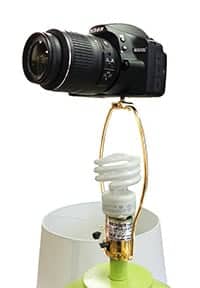
Tripod in a pinch!
1. No tripod? Use a lamp!
Want to take a group photo but don’t have a place to set the camera? Just whip the lamp shade off a lamp and screw your camera onto the lampshade-holder.
The thread size of the bolt on a lamp shade is exactly the same size as the filter thread used on tripods, so your camera will easily attach.
Not only will your party and indoor pictures look better, but you’ll look like MacGyver in front of the group. Not bad.
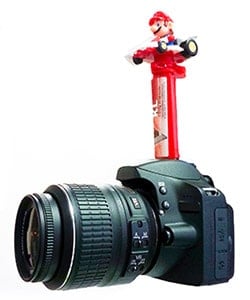
Gets attention of the kids and you can give them a treat for looking at the camera!
2. Put a PEZ dispenser on your hotshoe
Shooting photos of kids can be quite the feat. It seems like they are interested in looking at everything BUT the camera. I have two kids of my own, and I know that the only way to get them to smile and look at the camera is with a good bribe.
The perfect solution is to buy a simple PEZ dispenser on the hotshoe of your camera! The base of the PEZ dispenser is a tiny bit wider than a standard hotshoe, so you’ll have to trim it just slightly with a kitchen knife before the shoot. Then, when the kids are being good and looking at the PEZ dispenser, you can have them come up and grab a little candy periodically during the shoot. It’s pure genius.
3. Day to night in a flash
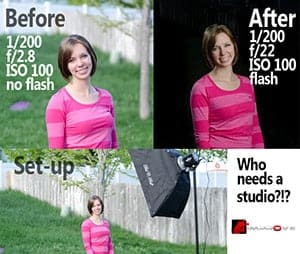
Turn your flash to FULL power!
Sometimes you’re out shooting portraits on a bright sunny day and the light just looks too… natural. I often find this is the case when shooting a wedding or engagement when I’m shooting at a park or other outdoor location and I get bored with the same lighting in every shot.
One trick that I really enjoy is to turn up the power on my flash to the max. This will, obviously, make the subject extremely bright. If you change your camera settings to expose for the subject, it will make the background look extremely dark because the flash didn’t hit it. This makes it look like it’s night time even if it’s the middle of the day. Click here to read a full explanation of this technique.
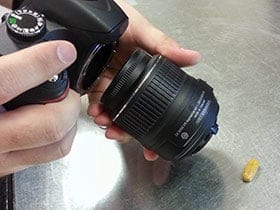
This photo shows the lens held out from the camera so you can see what’s happening, but you’ll want to hold the lens right against the camera for this to work.
4. Take your lens off for macro photography
This is the coolest camera trick I’ve seen in a long time. If you take off your lens and hold it in front of the camera, you get a macro lens! I was really skeptical about this, but I just tried it and it worked like a charm.
There are four things you need to know about using this trick: (1) Your camera won’t take a picture with the lens off unless you’re in manual mode. (2) The best focal length seems to be around 50mm, so either a 50mm prime or an 18-55mm kit lens would be perfect! (3) Obviously, you lose autofocus since your lens isn’t attached to the camera. Focus is achieved by simply moving closer to or further away from the subject, and (4) The camera can’t open up the aperture, so you’ll do it with your hand. On the back of the lens (the side you mount on the camera), move the little plastic slider piece that controls the aperture. If you look in the lens while doing it, you’ll see the hole open up.
If you want to take this a step further, you can buy a reverse lens mount for $5 or $10 which should sharpen up the images quite a bit since it will hold the lens more solidly. Also, be sure to use a tripod when doing this or any other macro photography. With such fine detail, even a tinymovement can destroy the sharpness.
5. Delete tourists from your travel photos

This little technique makes it EASY to get rid of the tourists in your travel shots!
This is an awesome trick for travel photographers. Sometimes you’re at an amazing location, but there are people in the way of your shot. If you want to take a picture of a landmark and people are in your shot, you will likely spend the rest of your adult life cloning people out of the shot unless you try this technique.
Step 1: Set your camera on a tripod.
Step 2: Take a picture about every 10 seconds until you have about 15 shots, depending on how fast people are walking around.
Step 3: Open all the images in Photoshop by going to File > Scripts > Statistics. Choose “median” and select the files you took.
Step 4: Bam! Photoshop finds what is different in the photos and simply removes it! Since the people moved around, it fills the area where someone was standing with part of another photo where no one was there.
UPDATE: The “statistics” script mentioned here is only available in Photoshop Extended or in the Creative Cloud version of Photoshop; however, as someone mentioned in the comments, you can get a somewhat similar effect in recent versions of Photoshop Elements by going to Enhance > Photomerge > Scene Cleaner.
This tip is mentioned in an outdated article on lifehacker.
 6. Shaped bokeh out of paper
6. Shaped bokeh out of paper
We all love to see beautiful bokeh in the background of our photos, but what you may not know is there is a really simple way that you can change the shape of the light bursts in your bokeh.
All you have to do is cut out a piece of black paper the size of the front element on your lens. Then, use a sharp kitchen knife or razor blade to cut a shape on in the middle of the paper. The shape should be slightly larger than a thumbnail or about the size of a U.S. nickel.
Keep in mind that you’ll only see this effect work if you are shooting with a large aperture, so a 50mm f/1.8 would be a great choice for this project. If you’re shooting at f/5.6 on a kit lens, you likely won’t see the effect at all.

This is a photo of the setup for this technique. When you overexpose the background and crop the reflector out, it looks like a perfect white background.
7. Reflector as studio backdrop
Sometimes when I’m shooting outdoor portraits, I see a pose or an expression for the model that makes me wish we were in the studio so I could photograph them on a white background. Sometimes a white background is the best way to focus all attention in the photo on the model, and it gives the photo a bright and clean look. When I’m in this situation, I often grab a simple $25 reflector and use it as a studio backdrop on the spot!
The trick for making this technique work is to use positive exposure compensation. The camera will try and dim down the white background to a dull gray because it thinks the white is overexposed. About 1 stop of exposure compensation will make the reflector background look bright white. If you’re still learning to shoot in manual mode or how exposure compensation works, you might take a look at my beginner photography class that I offer online.
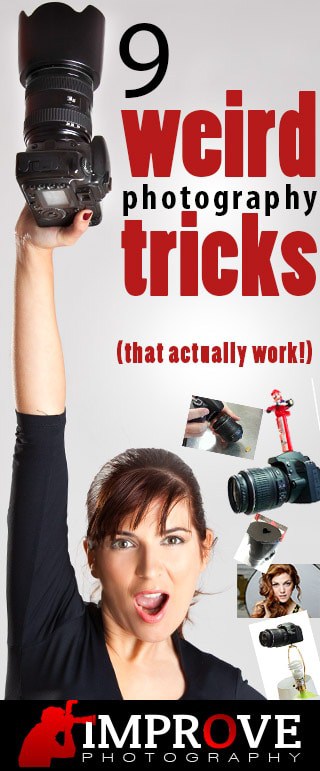
Ready for Pinterest!
8. Camera strap GND filter
This is my all-time favorite landscape photography tip because I use it all the time and most people have never heard it before. When shooting landscapes, the sky is often much brighter than the rest of the landscape so you need something to darken down just that top part of the photo. A graduated neutral density filter does exactly that.
A GND filter is a piece of glass that is darkened at the top and which gradually tapers off to clear. The photographer simply holds this filter in front of the lens to cover the sky and it darkens the sky without affecting the landscape underneath.
Call me forgetful, but I often forget to bring my GND filter with me when I’m shooting landscapes, and it can ruin the shoot if I can’t darken down the sky to balance the exposure. One trick I’ve learned is that you can simply use anything dark (a black piece of paper, a camera strap, etc) to hold in front of the lens for part of the exposure and the same thing is accomplished.
For example, while filming video tutorials formy intermediate online photography class, I was shooting waterfalls in Oregon and needed to darken the sky without darkening the rest of the frame. Since it was early morning, I was using a 2 second exposure. All I had to do was hold my camera strap over the top half of the glass on my lens for 1 second, and then remove it.
This makes it so the top half of the picture only sees light for half of the time, so it is much darker. And no, you won’t see the camera strap in the photo since it’s black.
9. Insulation reflector board
I debated whether or not this counts as a “camera trick” or if it’s really just a super-awesome reflector that costs basically nothing. Call it what you will, but it works so well that I have to share this tip.
Circular reflectors are excellent for improving the lighting in your outdoor portraits. By holding them to reflect the sun’s light, you can fill in shadows and put beautiful highlights on the face of the person you’re shooting. However, most circular reflectors only work for a head-and-shoulders shot and only for one person. You can purchase a large full-body reflector, but they usually cost around $70.

The back side is white.
One trick I learned from a photographer who shoots celebrities is to simply purchase insulation board for $5 and then cover the back and edges with white duct tape. You’ll find insulation board with reflective silver backing at any home improvement store. It comes in several sizes. I chose one that is 4 feet (1.2 meters) in height.
This simple solution gives you a very large reflector that is lightweight, and you can use one side to reflect silver and the other side to reflect white. Awesome!
Oh, and I also use this as a way to put a little wind in the hair of my models when I’m shooting someone with long hair. Just have an assistant fan up and down with the reflector board and it gives just the right amount of wind to give the hair some bounce without blowing the models away.
Success Secrets for photographers in 2014
If it’s not clear to you by now, then you should know I’ve always been bitten (and deeply) by the entrepreneurial bug. My primary motivation for starting PhotographyTalk.com was to help more people become better photographers. Just like the most successful entrepreneurs, many of whom are my heroes, I combined my passion with my recognition of a need in the marketplace, and happily confronted the challenge with all my energy, knowledge and resources.
One of the qualities of the successful entrepreneur that I like to think I recognized early is that what you need to know and do to succeed changes constantly, sometimes daily. That’s why my radar is always sweeping the marketplace, other entrepreneurs and the world in general to find the books, products and other items that will take me one step farther forward on the road to success. It’s a never-ending task and one I take seriously.
I’ve recently discovered 10 of these “personal and professional growth tools,” if you like, that I want to share with you. Many of them relate specifically to succeeding at the profession of photography, or making money or a living with your camera. Others will help you with any goals in your life, including improving your photography success, although you don’t aspire to own and operate a photography business. All of them offer ideas and information that I truly believe will help anyone. The deeper takeaway, however, is that, like me, you should be scheduling a significant portion of your day seeking similarly unusual or slightly offbeat products or aids that can have a profound effect on your life and whatever you want to do with it. Life, as well as photography, is a journey of discovery, which means there is something new to learn or experience everyday…if you are moving forward!
1. The Compound Effect by Darren Hardy
This book truly grabbed my attention, as it challenged me, as it will challenge you, to recognize the importance of knowing in what direction your compass is pointed. It helps to clarify the effect and meaning of your actions, not just today, but also 2, 5 and 10+ years down the road. The author’s message should resonate with any photographer whether his or her goals are casual or professional. This book is a game changer and I highly recommend it as one that must be in your library. This book sheds new light on the concept of goal-setting and important principles that will shape your success in any career and your personal life. It focuses on the small, everyday routine decisions that we all make. During a 24-hour day, they might not seem like much, but when compounded during a longer period of time, they will either take us to our desired goals or to struggle and hardship. You may also want to purchase the audio version, so you can listen to it in your car, as I often do (Running the simplest errands in Southern California can take hours).


Click here to order The Compound Effect from Amazon.com.
2. Green Vibrance
The label of this product calls it “A Comprehensive, Restorative, Advanced Daily Superfood + Vegan D3.” The label also states that it contains 25 billion probiotics. I don’t know what you think of these kinds of supplements, but I know it works for me. I think it’s worth a few bucks to determine if it has the same positive effect on you. Like me, I’m sure you are working long hours and in contact with many people...and their germs and viruses. Staying healthy allows us to spend more time with our cameras and provide support for our families (not necessarily in that order).
I’m a believer in this product and take it daily. It proved to make a big difference when I spent a week in Tennessee with people from Sony. The company flew me to the Hickory State during October to see its new A7r mirrorless camera. Five days prior to my departure, my wife took three days off work because she caught a bad cold. Now, I had been already taking daily servings of Green Vibrance, so I started to double my intake that week. Green Vibrance is a powder you mix in the appropriate beverage. It’s also available in capsule form. I had no intention of missing my trip to Tennessee with Sony, or arrive sick, and potentially spread my wife’s cold among my Sony hosts (That could have been awkward). With a bit of tongue-of-cheek humor, I’ve told many people that Green Vibrance is its own food group. The healthcare community and FDA may not recognize it as such, but it’s a great drink that will supercharge your immune system when you need it!



Click here to order Green Vibrance from Amazon.com.
3. Writing a Daily Journal
Few entrepreneurs have had as profound an effect on me as Richard Branson. I like to think of him as the mentor I’ve never met, except through his books. He, as well as other entrepreneurs who have experienced similar success, take the time everyday to write in a journal. Not only will this exercise help to record daily decisions and events that could prove useful in the future (and you might otherwise forget), but also scientific research has shown that recording your daily thoughts and feelings is good for your health. It allows you to be in more control of your life, and can boost your happiness, self-esteem and productivity. Now, you can keep your journal on your computer or tablet, but many journal writers say the positive effect is even greater when you write with a pen or pencil (you remember them) in a nicely bound journal. You don’t have to write much, maybe a few hundred words, but you may be surprised how different you’ll feel after a few weeks of this daily exercise and what you wrote when you review old entries.


Click here to order a nice bound, moleskin or leather journal from Amazon.com.
4. Fascinate: Your 7 Triggers to Persuasion and Captivation by Sally Hogshead
Here’s another book that captivated me, which is the point of the book. The word, “fascinate,” is actually based on a Latin word that means “witchcraft,” which uses spells and magic potions to hold you spellbound. In the context of this book, the author uses the word to help a company make its products and/or services irresistible to its customers. Fascinate is certainly a word that applies to photography. As your skills improve, your images should prove to be more fascinating and alluring to those who view them. Understanding how to persuade and influence others through your images is a worthy goal as a photographer. When people are transfixed by your compositions, it’s a sure sign that you are succeeding.


Click here to order Fascinate: Your 7 Triggers to Persuasion and Captivation from Amazon.com.
5. Business Plan Software
If your goal is to succeed at professional photography, in any capacity, then reaching your goal will be much more difficult, if not impossible, without a business plan. Such a plan doesn’t need to be dozens of pages or address all the very precise specifics of what kind of business you want or how you would operate it. In fact, it would be a mistake to develop a business plan that is too rigid or one you think you must follow exactly. The best business plans include some flexibility or contingencies, so you can make adjustments as the marketplace and opportunities change. Successful entrepreneurs, and photographers, would tell you that their best-laid plans were abandoned in whole or part because of new opportunities they never contemplated in advance. Writing a business plan is even easier today because there are so many guides and software packages available.


Click here to browse business plan software at Amazon.com.
6. Legal Handbook for Photographers: The Rights and Liabilities of Making Imagesby Bert P. Krages
In legal terms, what you produce as a photographer is intellectual property. Given the litigious society in which we live, your success could be derailed without any warning if you don’t understand your legal rights. This book receives 4.5 stars on Amazon’s 5-star scale, so you know it has helped many photographers and probably saved the bacon of quite a few. You protect yourself and your future success when you know the legalities of shooting on private property, copyrighted materials and children (to name a few) and how the national security laws apply to photographers. This should be one of the most important books in your library.
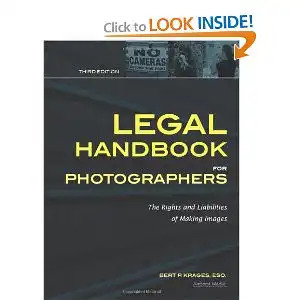
Click here to order Legal Handbook for Photographers: The Rights and Liabilities of Making Images from Amazon.com.
7. Marketing Your Photography
The greatest stumbling block for many photographers, who have dreams of succeeding as a pro or business owner, is not photography techniques or even legal issues, but marketing. With the addition of online, social media and mobile marketing to the mix of sales channels, successfully marketing yourself and your work may seem overwhelming. Like any subject, however, it starts with knowledge; and Amazon is filled with excellent books on general marketing of photography as well as using online and social media. I think it is safe to say that the new marketing channels fit photographers much better than traditional marketing tactics, such as newspapers, direct mail and broadcast. Most of these are too expensive, can’t be precisely directed at a specific audience and aren’t immediate enough for today’s online, socially conscious and mobile consumers.

Click here to find a great selection of books on marketing at Amazon.com.
8. Drive!
Ambition, persistence and ceaseless motivation, whatever term you use, it is an essential ingredient of success...and it’s free! A few people seem to be born with it, but, for most of us, we need an outside influence to fire our passion and cause us to drive hard for our goals. Of course, the marketplace is overflowing with books, CD and DVD series, seminars, workshops, etc. providing motivational tools. Without a doubt, the #1 book is Stephen Covey’s The 7 Habits of Highly Effective People: Lessons in Personal Change. It’s a good place to start because what you read and learn should motivate you to want to know more. It’s easy to become a “motivational junkie,” spending too much of your time filling yourself with drive and ambition, and not enough time applying what you’ve learned. Be selective, which is why it’s important to talk with accomplished, successful photographers and/or find a mentor to understand how they motivate themselves.
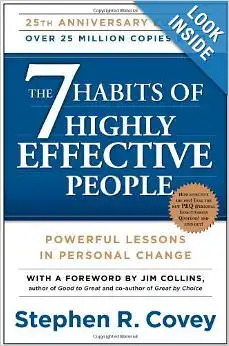
Click here to order The 7 Habits of Highly Effective People: Lessons in Personal Change from Amazon.com.
9. Bowers & Wilkins C5 In-Ear Headphone
Because of my busy schedule, I find it convenient to listen to podcasts and motivational and marketing content when I’m at the gym or even shooting. I found this Bowers & Wilkins C5 headset to be far superior to the typical ear buds. With most ear buds on the market you can’t move your head much or certainly exercise without them falling from your ears. The Bowers & Wilkins C5's are designed to remain secure (and they do!), regardless of what you are doing. I can’t say enough about this headphone’s amazing sound quality, which is especially important when listening to someone speak. Plus, the MFi cable is Apple-approved, so this headset works perfectly with your iPhone or iPod. The cable also has a remote control and microphone.
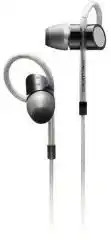
Click here to order Bowers & Wilkins C5 In-Ear Headphone from Amazon.com.
10. Microsoft Surface Pro 2
I’m firmly convinced that Microsoft has created a device quite different in the Surface Pro 2, and one that fits a photographer’s needs precisely. You’ll learn all the details about this new “tablet/computer” when you read the series of articles at PhotographyTalk.com. What sets the Surface Pro 2 apart from the typical laptop is that it is smaller and lighter, but with a screen that is almost the same size. More importantly, the Surface Pro 2 operates as both a tablet and a fully functioning computer when you add an optional keyboard. The big win-win for photographers when comparing it to an iPad Air is that the Surface Pro 2 runs Photoshop and Lightroom, which the iPad Air doesn’t. I think the Surface Pro 2 is definitely a success tool for photographers and offers all the specs you’ll ever need in a “field” or on-location computer.

Click here to order Microsoft Surface Pro 2 with 128GB SSD and 4GB of memory.
I could have probably continued this list until it was book length, but success as a photographer doesn’t occur overnight, so I wanted to provide you with just 10 of the success tools that are often overlooked or I’ve found to be helpful to me. The great thing about success is that it’s always available to pursue and achieve, which is why learning how to succeed and applying success tools and aids must be a lifelong task; therefore, you best start today!
Subscribe to:
Comments (Atom)






















